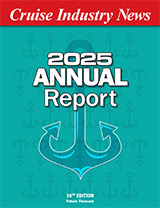From Jan. 1, 2015 the fuel regulations for ships arriving at Svalbard will be fully implemented. These regulations, known as “the heavy oil ban”, mean that no ships can sail within the borders of the national parks on the East and West Coast of the archipelago with that kind of fuel on board, according to Cruise Norway. An exception was made for cruise ships to be able to visit Magdalenefjorden and Ny-Alesund on the West Coast of Spitsbergen, an exception that will be terminated after 2015.
The Governor of Svalbard issued information on the fuel regulations recently, that apparently has led to some confusion, which the Norwegian cruise marketing association said it is trying to clear up with the statement issued today.
Cruise Norway said the big question is: does the heavy oil ban mean that all cruise traffic to Svalbard is to be stopped, knowing that heavy oil is still the dominant fuel? The quick answer is: no, but it is not as simple as that, the association added and explained as follows:
All cruise ships and other ships with heavy fuel are allowed to visit Longyearbyen and Isfjorden (the Ice Fjord) after Jan. 1, 2015, via a permanent specific corridor. Acknowledging the fact that many of the cruise companies have Magdalenefjorden and Ny-Alesund featured as highlights on their visits, Svalbard Tourism and the tourism businesses in Longyearbyen have joined forces to find other attractions in order to keep overseas cruise tourism on Svalbard.
They have responded as follows: Cruise Network Longyearbyen: Businesses in Longyearbyen have created the Cruise Network Longyearbyen, in order to improve how all facilities in the city are coordinated during cruise calls. Their goal is to provide more shore excursions with sufficient capacity, better utilization of scarce resources (like buses), welcoming arrangements on the pier, etc.
Longyearbyen: Local companies are joining forces to better serve cruise lines with shore excursion options, like hiking, glacier walks, dog sledding, visits to dog yards, boat trips, sightseeing, museums, art & culture, etc. The capacity with coordinated suppliers is about 2,000 passengers within an eight-hour stay. Shops, museums and galleries will offer more flexible opening hours. Overnight stays are also made more attractive with participating restaurants, pubs and bars.
Isfjorden (the Ice Fjord): As an alternative to visits to the Magdalenefjorden and Ny-Alesund, plans call for developing the Isfjorden-system as an extended destination for ships calling at Longyearbyen. This huge fjord system is attractive for numerous reasons: The “ghost town” of Pyramiden, the abandoned Russian settlement – now prepared for visits, including guides and lunch. Glaciers, mountains, bird cliffs, wildlife and an exceptional geology provide locations to visit on shore.
Logistics regarding the port, the airport and pilotage: The Longyear Airport (LYR) is an international airport handling aircrafts up to the size of a Boeing 737. The international Port of Longyearbyen is located three kilometers or two miles from the airport and is well established as a turnaround port for cruise calls, handling approximately 10 000 cruise passengers on turnarounds in 2013.
The port will be extended over the next couple of years, offering more capacity and improved facilities for visitors in the port area.
Combining visits to Longyearbyen and Isfjorden also provides cost savings as both fuel and pilotage expenses will drop substantially. Longyearbyen is only five nautical miles from the nearest pilot embarkation area.
The HFO ban in most protected areas of Svalbard has existed since 2007 and 2010. Ships carrying HFO cannot sail in South Spitsbergen National Park, Forlandet National Park, Northwest Spitsbergen National Park and the nature reserves on the east side of Svalbard (also there is a maximum ship capacity of 200 passengers allowed). The national parks extend to the 12 nautical mile limit from shore. The objective of these restrictions is to avoid major pollution from heavy bunker oil in case of an accident at sea and to limit the environmental damage caused if it should occur. This regulation means that heavy bunker oil is prohibited within most of Svalbard’s territorial waters.



